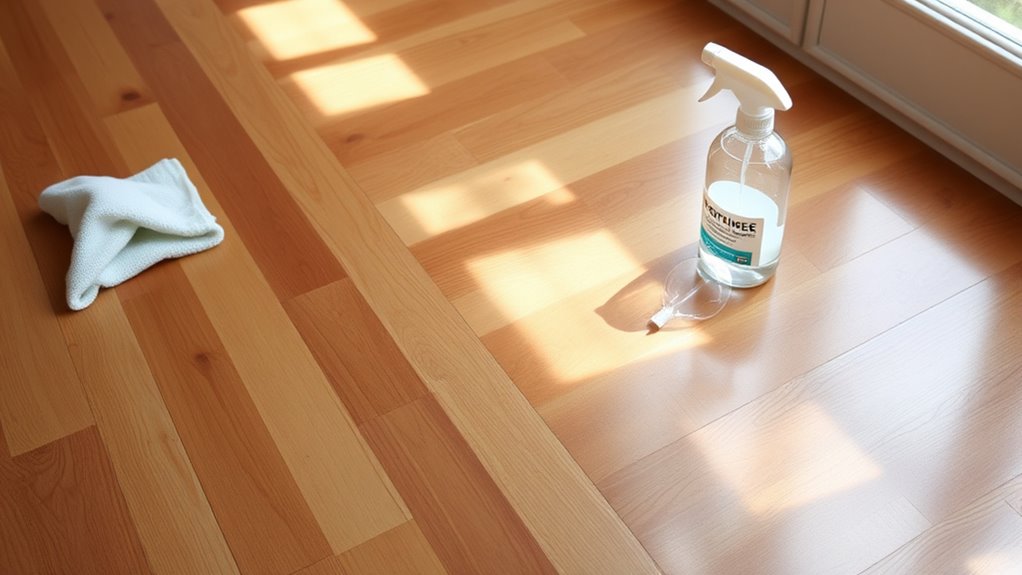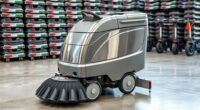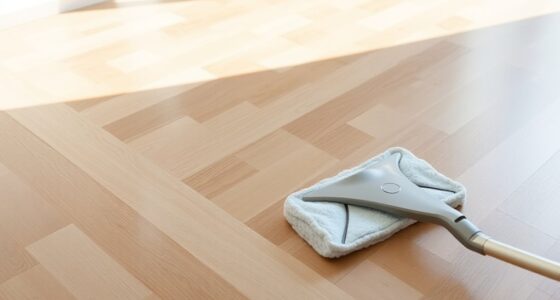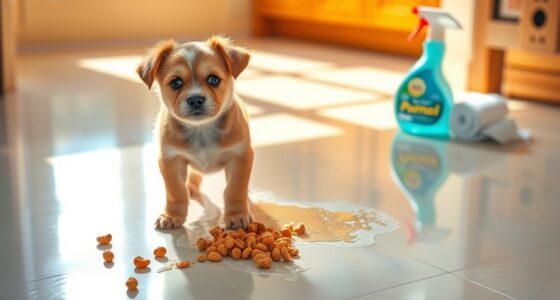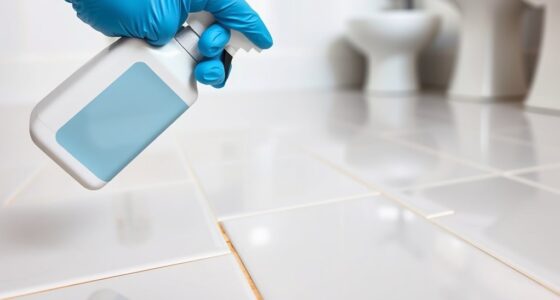To disinfect your sealed hardwood floors safely, use pH-neutral cleaners or disinfectants formulated specifically for hardwood surfaces. Diluted disinfectants can help eliminate germs without damaging the finish. Avoid harsh chemicals like bleach, ammonia, or abrasive scrubbers, and never leave solutions sitting too long. Make sure to wipe with a well-wrung cloth or mop to prevent excess moisture. Keep reading to uncover essential tips for maintaining your floors’ beauty and longevity.
Key Takeaways
- Use pH-neutral, hardwood-specific disinfectants diluted according to manufacturer instructions.
- Avoid harsh chemicals like bleach, ammonia, or abrasive cleaners that can damage the finish.
- Select disinfectants formulated for sealed hardwood to ensure effective germ-killing without harm.
- Never allow disinfectant solutions to sit or pool on the surface; wipe immediately with a well-wrung cloth or mop.
- Steer clear of steel wool, abrasive scrubbers, or excessive water to prevent scratches, warping, or moisture damage.

Sealed hardwood floors are durable and easy to maintain, but they still need regular disinfecting to keep them germ-free. By establishing a consistent cleaning frequency, you guarantee that dirt, bacteria, and germs don’t accumulate, which helps preserve the floor’s appearance and hygiene. Cleaning often enough to keep the surface looking fresh while avoiding overdoing it is key. Usually, a gentle sweep or vacuum daily removes loose debris that can scratch or damage the finish. Following up with a damp microfiber mop a few times a week helps eliminate grime without saturating the wood. This routine not only keeps your floors visually appealing but also enhances surface protection, preventing damage caused by dirt and moisture buildup. Using appropriate cleaning products designed for sealed hardwood can further ensure the longevity of your flooring. When it comes to disinfecting, choosing the right products is essential. You want solutions that effectively kill germs but won’t compromise the integrity of your sealed hardwood. Harsh chemicals, like bleach or ammonia-based cleaners, might seem effective but can strip or dull the finish over time. Instead, opt for disinfectants specifically formulated for hardwood surfaces, or use diluted solutions of gentle, pH-neutral cleaners. These products provide the necessary germ-killing power while maintaining the floor’s surface protection. Always read labels carefully and follow manufacturer instructions to avoid applying too much solution or letting it sit too long, which can damage the finish. Avoid using abrasive scrubbers or steel wool when cleaning your sealed hardwood. These tools can scratch the surface, making it more vulnerable to staining and wear. Similarly, steer clear of overly wet mops or excessive water, since standing moisture can seep into the seams and cause warping or swelling. Instead, use a well-wrung mop or cloth to keep the surface moist but not soaked. Proper surface protection also involves promptly wiping up spills to prevent liquids from seeping into the wood, which can compromise the seal and lead to more extensive damage.
Frequently Asked Questions
Can I Use Bleach to Disinfect Sealed Hardwood?
You shouldn’t use bleach to disinfect sealed hardwood because of bleach risks, which include damaging the sealant and causing discoloration. Bleach can weaken the protective finish, making your floor more vulnerable to damage. Instead, opt for gentle, hardwood-safe disinfectants that are compatible with your sealant. Always check the product label and test a small, hidden area first to ensure it won’t harm your sealed hardwood floor.
How Often Should I Disinfect Sealed Hardwood Floors?
Ever wonder how often you should disinfect your sealed hardwood floors? Generally, cleaning once a week works well for routine maintenance, but increase the frequency if you have high foot traffic or pets. Regular cleaning helps keep germs at bay and preserves your floors’ finish. Follow proper cleaning tips like using gentle cleaners and avoiding excess water to maintain their beauty and longevity. Staying consistent guarantees your floors stay spotless and safe.
Are Natural Disinfectants Safe for Sealed Hardwood?
Yes, natural alternatives can be safe for cleaning sealed hardwood floors if used correctly. You’ll want to make certain you choose gentle, non-abrasive options like diluted vinegar or castile soap, which provide safe cleaning without damaging the sealant. Always test a small area first and avoid harsh chemicals or excessive moisture. This way, you effectively disinfect while protecting your floors’ finish and maintaining a healthy home environment.
Will Disinfectants Damage the Finish of Sealed Hardwood?
Your sealed hardwood finish is resilient but not invincible, so disinfectants can damage it if they cause harsh chemical reactions. Strong chemicals may dull or strip the finish, compromising its durability. To keep your floor looking pristine, avoid harsh disinfectants and opt for gentle solutions. With proper care, your sealed hardwood’s finish remains shiny and durable, standing strong against daily wear and tear like a fortress.
How Do I Remove Stains After Disinfecting Sealed Hardwood?
To remove stains after disinfecting sealed hardwood, start with gentle cleaning techniques like a mixture of mild soap and water. For stubborn stains, apply a small amount of baking soda paste or use a specialized wood stain removal product. Always test in a hidden area first to prevent damage. Avoid harsh chemicals, as they can harm the finish. Consistent, gentle cleaning helps keep your hardwood looking its best.
Conclusion
So, next time you’re worried about disinfecting your sealed hardwood, remember: the safest options are gentle cleaners—you know, the ones you’d actually want to touch your face. Ironically, trying to be overly cautious with harsh chemicals might do more harm than good. Sometimes, keeping it simple and sticking to recommended products is the smartest move. After all, your beautiful floors deserve love, not risky experiments. Happy cleaning—without the accidental science project!
